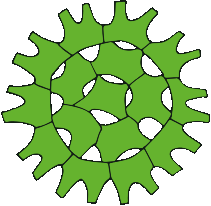seems to be a species that occurs when the ecosystem is in stress (Leitão et al 2003, Song et la 2009). The Dutch TWN-list has 3 "preferred names" for Planctonema: 2 lauterbornii's and Planctonema subtilissimum. There is Planctonema lauterbornii Schmidle 1903, but then also Pl. lauterbornii sensu M. Watanabe, T. Hori et M. Akiyama 1986. I looked up the article of Watanabe & Co , but - I must say - some of the information did not exactly reach my brain. Maybe it was the Japanese language. So it remains a mystery to me, why Watanabe et al's lauterbornii should be recorded ap...
Read More
Month: November 2011
Tychonema
Hmm, it's true, then. They are here. Tychonema's. On the Cyanobactria course in Czech Rebublic last August I was quite surprised to hear Prof. Komárek say that Tychonema is quite common in the northern lakes... As he, together with Anagnostidis, wrote in Süsswasserflora 19/2 (2005) they occur "in the plankton of northern, colder lakes, slightly eutrophicated". Found some in a northern lake. Tychonema resembles a lot Planktothrix, and is very closely related too. Both belong to the family Phormidiacea and even to the subfamily Phormidioideae. What is different between these genera is that in T...
Read More
Pediastrum
Found this Pediastrum integrum C.W. Nägeli 1849 in a sample with almost nothing in it. And yes, Komárek and Jankovská (2001) tell that it's common in oligotrophic and dystrophic cold and clear large and small lakes as well as small peaty basins. Everything fine so far. What puzzled me was there also was P. angulosum (C.G. Ehrenberg 1834) ex G.G.A. Meneghini 1840, which Komárek and Jankovská (2001) describe as "rather alkalifilic and does not occur in peaty waters an acidic swamps." But then again, I only saw two coenobia, one of each. In 25 ml. And of course they could occur simultaneu...
Read More
Catalogue of the desmids of Ireland
Wonderful! To be found at AlgaeBase: http://www.algaebase.org/search/bibliography/detail/?biblio_id=47220
Read More
The big one
This big (68x80 µm) Cosmarium botrytis lightened up my day just before lunch break. It was cathed in a lake Kurtinjärvi in Kuusamo, in the north of Finland. West & West (1912) already mention, that it has been seen in Finland. A quite a common species, found all over. West & West describe 7 varieties of this species with "considerable amount of variability": paxillosporum, subtumidum, tumidum, gemmiferum, emarginatum, mediolaeve and depressum. They only mention var. gemmiferum as seen in Finland at that time. Skuja mentions the species in some northern lakes in Sweden in 1948, with 3 ...
Read More
They still love Zooplankton!
In the newest Hydrobiologia (Volume 676, Number 1 / November 2011) there is a bunch of articles about zooplankton. Wonderful! "Cladocera crustaceans: sentinels of environmental change" Eggermont & Martens write in the preface. I do believe they are. Jeppesen et al plead for including zooplankton to the European Water Framework Directive. No objections heard from me. What makes me especially happy is the high number of Finnishs names as authors.
Read More
